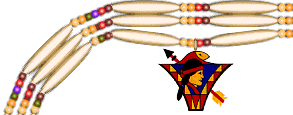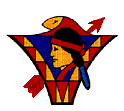A Brief History of Navajo Lodge
Founding Of The Order Of The Arrow
In the summer of 1915, E. Urner Goodman and Carroll A Edson, then the leaders of the Philadelphia Council Camp on Treasure Island in the Delaware River north of Philadelphia, sought a definite system of recognizing those scouts who best represented the Scout Oath and Law. They organized a camp society originally called Wimachtendienk, W. W. and later known as the Order of the Arrow.
Its first meetings and ceremonies were held in a place in the woods not generally used for activities. Here they created a council ring where all honors, including promotions in Scouting, were awarded. As the highest camp honor, one Scout was chosen to be inducted into the Order by each troop at the end of its stay in camp. This was the beginning of the Order. After the public ceremonials, those candidates who had previously undergone an ordeal were, with appropriate ceremony, admitted to the Order. Twenty-six persons were inducted in the first year.
The idea of recognition to honor campers was not a unique one. There were many early camping societies, such as the White Swastika, Order of the Ku Ne-Eh, Mic O-Say, Firecrafters and the Order of Taquitz, to name but a few. The Order was unique, however, in that its members were elected by the peers of the Scout in his troop, not by members of the Order. Also, it was founded upon sound principles that have contributed mightily to the survival and growth of the Order. The principles of the Order - Brotherhood, Cheerfulness and Service - have instilled a spirit in the members of the Order to continue to promote the value of the camping experience learned in God's great outdoors.
In the fall of 1934, the BSA agreed to absorb the Order into its Scouting program and make it a national program experiment. This lasted until 1948 when it became an official part of the BSA program.
Founding Of Navajo Lodge
It now appears the Old Baldy Council at its Camp Tulakes had a camping society which had the name of Navajo. The name of Navajo appears to have been chosen because of some involvement of the local scouts with Navajo Indians in the area. On March 25, 1935, O. A. Alderson the Scout Executive of Old Baldy Council wrote to National asking for information on the Order. The information was mailed back to the Council on April 2, 1935. In the summer of 1935, the first inductions were held during summer camp. The Council finally got around to mailing an application to the National Office on December 28, 1936, which was approved on January 17, 1937. This is the founding date of the Navajo Lodge.
In conversations with and a letter from Jack Atwood, our first Lodge Chief, it appears that O. A. Alderson asked him to implement the program because he was a camp staff member. He picked some other camp staff members and they started inducting members during the 4-week camp season in the summer of 1935 at Camp Tulakes. They inducted 32 members during that summer and the following two summers. These are our founding members.
On July 2, 1937, John Voss the Camp Director, wrote to National inquiring about the ceremonies of induction and if
"It was necessary to have a member of an already existing lodge present to install members of the new organization."
H. Lloyd Nelson, the National Scribe, was out of town when the letter arrived so his secretary wrote saying that
"To the best of my knowledge I believe this is necessary. However, I will have Mr. Nelson write you just as soon as he returns to his office."
Fortunately Mr. Nelson returned the next day and replied as follows:
"The information my secretary gave you applies in the usual cases but as you are so far from any of our well established Lodges it would be almost impossible for a delegation from an already existing Lodge to install your new Lodge. Under these circumstances, I am sending your this letter by air mail and enclosing herewith copy of booklet first Ritual for the Ordeal (first) Honor. The enclosed booklet should, therefore, not be used for any purpose except for you to memorize the information which I have written in it, after which it should be destroyed by burning."
It appears that the Lodge in the early years had the following officers: Chief, Secretary, Treasurer, Social Chairman and Advisers. They apparently had some social activities during the winter and conducted inductions during the summer.
Lodge Pow Wow's
The next major change in the Lodge program occurred in 1955, when the Lodge held the first of its Pow Wow's, 17 of them consecutively. The Pow Wow was a time for the Lodge to get together and have fellowship, Indian lore, ceremonies, and elect Lodge and Chapter Officers. Many of these Pow Wow's were held with other Lodges, most often with A-Tsa Lodge out of Redlands. They were generally held in September or October with a few in November and December. Most of them had a make-up Ordeal going on during the Pow Wow.
Pow Wow 18 was postponed one year. The reason was the Scout Executive, Ron Brundage, had instituted a policy that if you did not have at least 20 members signed up 2 weeks prior to an activity you would cancel the activity. The next Pow Wow canceled was Pow Wow 21 in 1976. Again the Scout Executive, Ron Brundage, had the policy of 20 members must be signed up 2 weeks prior to the event. Since the Pow Wow patch was dated it was sold over the counter and at lodge events. Pow Wow 23 in 1978 was also canceled due to the same policy. The patches to this Pow Wow had already been ordered and received. They were put in the safe at the Council Office, and stayed there for several years, when about half of them were put on sale in the Council Office. The other half were not found until the Council moved to the new Council Office in Ontario.
The next Pow Wow number 24 was held in 1984 and we had them for 5 consecutive years. Another break occurred between 1989 and 1997. On January 17, 1997 we held our 30th Pow Wow to celebrate the 60th anniversary of our founding. In November 2000 we held our 33rd Pow Wow.
Lodge Organization
It was around 1955 when the Lodge went to a clan organization. They were based on the Councils districts. They also had the following Lodge Officers; Chief, Sub-Chief, Medicine Man, Secretary-Treasurer. This organization held until 1966 when the office of Secretary-Treasurer was split, to bring the Lodge into compliance with National program. Also, in 1966, we changed from calling the district organization Clans to Chapters, and went to January through December program year instead of an October through September program year. We stayed with this program year until 1971 when we switched to a program year of September through August which is how we are now organized.
Lodge Program
The Lodge program during this time was a fall Pow Wow/Ordeal, followed by the Annual Dinner. Unit visits for camp promotions were held year round, with the lodge taking slides during summer camp and showing them to the units. After the first of the year we would start conducting Unit Elections for a spring Ordeal. Also, in the spring, they attended the Area 12-A Conference, which since 1973 was changed to the Section W4B Conclave.
Vigil Honor
The Vigil Honor is the highest honor that the Order of the Arrow can bestow upon its members for service to the Lodge, the Council, the Camp or to Scouting. It dates from 1915, when founder E. Urner Goodman became the first Vigil Honor member. Our first Vigil induction was held on April 15, 1955 at the Area 12-A Conference at Camp Emerson, where Virgil Burson the Lodge Adviser went through his Vigil. He was the lone member of the Lodge to be selected in that first Vigil selection. We have had as of 2002 38 Vigil Honor selections groups. We have selected 145 members for the Vigil Honor 88 youth members and 57 adult members.
Founder's Award
In 1981 the National Committee established a new award to memorialize founder E. Urner Goodman and cofounder Carroll A. Edson. It was in response to frequent request form lodges for a local award beyond the Vigil Honor. The Vigil Honor, once a very rare award, was now given much more frequently. With the growth of the Order over the years, many adults chosen for the Vigil Honor as youths remained involved. Lodges continued to look for additional ways to recognize exceptional service carried out over an extended period of time.
With the death of E. Urner Goodman in 1980, the National Committee decided that the time was right to reinforce the values of service first established by the founders. They created the Founder's Award. It was to be available for a maximum of two presentations in a lodge each year. This low number would limit the award to those truly deserving. Like the Vigil Honor, Founder's Awards must be approved by the National Order of the Arrow Committee through the National Director of the Order of the Arrow. Recipients are presented with an engraved plaque, and authorized to wear a special red ribbon arrow pin.
Our first selections were Anthony Beyenhof a youth who had been Lodge Chief and Section W4B Chief, and William Woodward an adult who had been Lodge Chief and Lodge Adviser. They were awarded on March 26, 1986. As of 2002, we have made 13 selections, 10 times for 2 members and 3 times for only 1 member. Of the 23 members of our Lodge who have received the Founder's Award, 17 were for what they had done as a youth member, 1 for what he had done as a youth and adult member, and 5 for what they had done as an adult member.
With the demise of Canilino Lodge in Santa Barbara, Navajo Lodge is the oldest Lodge in California and the third oldest in the Western Region.
Prepared by
William Woodward
Lodge Chief 65 - 66
Lodge Adviser 71 - 73, 87 - 89, 96, 97
Special thanks to the following for providing information in this history:
Jack Atwood
Larry Mardis
Jerry Vinatieri
Mike Riley
Prepared December 17, 1998
2nd Revision October 26, 2002


